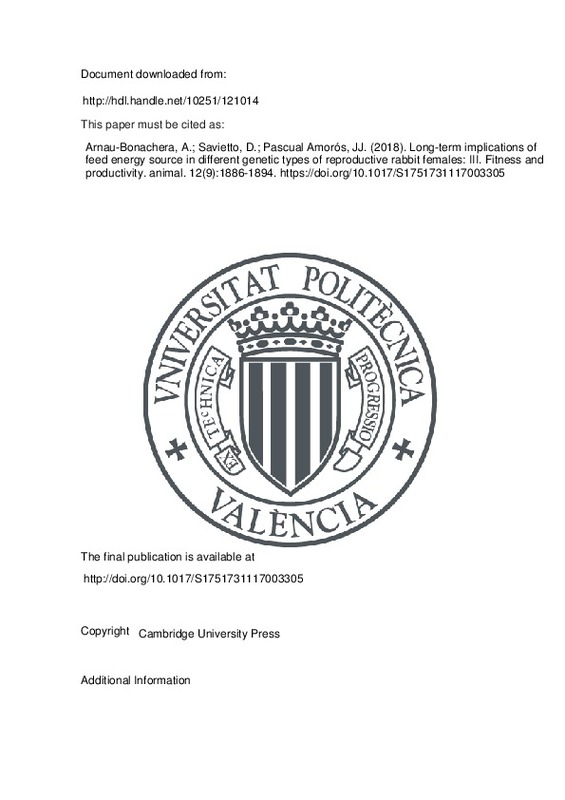JavaScript is disabled for your browser. Some features of this site may not work without it.
Buscar en RiuNet
Listar
Mi cuenta
Estadísticas
Ayuda RiuNet
Admin. UPV
Long-term implications of feed energy source in different genetic types of reproductive rabbit females: III. Fitness and productivity
Mostrar el registro sencillo del ítem
Ficheros en el ítem
| dc.contributor.author | Arnau-Bonachera, Alberto
|
es_ES |
| dc.contributor.author | Savietto, Davi
|
es_ES |
| dc.contributor.author | Pascual Amorós, Juan José
|
es_ES |
| dc.date.accessioned | 2019-05-23T20:04:04Z | |
| dc.date.available | 2019-05-23T20:04:04Z | |
| dc.date.issued | 2018 | es_ES |
| dc.identifier.issn | 1751-7311 | es_ES |
| dc.identifier.uri | http://hdl.handle.net/10251/121014 | |
| dc.description.abstract | [EN] The specialization process associated with genetic selection could be associated with functional disorders, affecting the reproductive success of females (fitness). We hypothesized that by modulating energy acquisition and allocation of females we could balance productivity and reproductive success. To test this hypothesis, we used 203 rabbit females belonging to three genetic types: H (n=66) maternal line specialized in prolificacy, LP (n=67) generalist maternal line, R (n=70) paternal line specialized in growth rate. We fed each genetic type with two diets specifically designed to promote milk yield (AF) or body reserves recovery (CS). We controlled females between their first and fifth reproductive cycles, recording traits related with productivity and fitness of females. H females fed CS had on average 11.2 +/- 0.43 kits with an individual weight of 54 +/- 1.2 g at birth and 525 +/- 11 g at weaning. Their conception rate when multiparous was 44% and their survival rate at the end of the experiment 30%. When they were fed AF, the individual weight of kits was 3.8 g heavier (P<0.05) at birth and 38 g heavier at weaning (P<0.05), the conception rate when multiparous increased 23 percentage points (P<0.05) and the survival rate at the end of the experiment 25 percentage points (P<0.05). LP females fed CS had on average 10.8 +/- 0.43 kits with an individual weight of 52 +/- 1.2 g at birth and 578 +/- 11 g at weaning. Their conception rate when multiparous was 79% and their survival rate at the end of the experiment 75%. When they were fed AF, it only increased individual weight of kits at weaning (+39 g; P<0.05). R females fed CS had on average 8.4 +/- 0.43 kits with an individual weight of 60 +/- 1.2 g at birth and 568 +/- 11 g at weaning. Their conception rate when multiparous was 60% and their survival rate at the end of the experiment 37%. When they were fed AF, they presented 1.4 kits less at birth (P<0.05) but heavier at birth (+4.9 g; P<0.05) and at weaning (+37 g; P<0.05). Therefore, we observed that genetic types prioritized different fitness components and that diets could affected them. In this sense, seems that more specialized genetic types, were more sensitive to diets than the more generalist type. | es_ES |
| dc.description.sponsorship | This study was supported by the Interministerial Commission for Science and Technology (CICYT) of the Spanish Government (AGL2014-53405-C2-1-P). The authors thank Juan Carlos Moreno for his technical support. Grants for Alberto Arnau from the Ministry of Economy and Finance (BES-2012-052345) are also gratefully acknowledged. | es_ES |
| dc.language | Inglés | es_ES |
| dc.publisher | Cambridge University Press | es_ES |
| dc.relation.ispartof | animal | es_ES |
| dc.rights | Reserva de todos los derechos | es_ES |
| dc.subject | Functionality | es_ES |
| dc.subject | Productivity | es_ES |
| dc.subject | Priority | es_ES |
| dc.subject | Trade-off | es_ES |
| dc.subject | Long term | es_ES |
| dc.subject.classification | PRODUCCION ANIMAL | es_ES |
| dc.title | Long-term implications of feed energy source in different genetic types of reproductive rabbit females: III. Fitness and productivity | es_ES |
| dc.type | Artículo | es_ES |
| dc.identifier.doi | 10.1017/S1751731117003305 | es_ES |
| dc.relation.projectID | info:eu-repo/grantAgreement/MINECO//AGL2014-53405-C2-1-P/ES/MEJORA GENETICA DEL CONEJO DE CARNE:RESPUESTA A LA SELECCION Y SU EFECTO SOBRE LA REPRODUCCION, ALIMENTACION Y SALUD UTILIZANDO UNA POBLACION CONTROL CRIOCONSERVADA/ | es_ES |
| dc.relation.projectID | info:eu-repo/grantAgreement/MINECO//BES-2012-052345/ES/BES-2012-052345/ | es_ES |
| dc.rights.accessRights | Abierto | es_ES |
| dc.contributor.affiliation | Universitat Politècnica de València. Departamento de Ciencia Animal - Departament de Ciència Animal | es_ES |
| dc.description.bibliographicCitation | Arnau-Bonachera, A.; Savietto, D.; Pascual Amorós, JJ. (2018). Long-term implications of feed energy source in different genetic types of reproductive rabbit females: III. Fitness and productivity. animal. 12(9):1886-1894. https://doi.org/10.1017/S1751731117003305 | es_ES |
| dc.description.accrualMethod | S | es_ES |
| dc.relation.publisherversion | http://doi.org/10.1017/S1751731117003305 | es_ES |
| dc.description.upvformatpinicio | 1886 | es_ES |
| dc.description.upvformatpfin | 1894 | es_ES |
| dc.type.version | info:eu-repo/semantics/publishedVersion | es_ES |
| dc.description.volume | 12 | es_ES |
| dc.description.issue | 9 | es_ES |
| dc.identifier.pmid | 29224584 | |
| dc.relation.pasarela | S\355324 | es_ES |
| dc.contributor.funder | Ministerio de Economía y Empresa | es_ES |
| dc.contributor.funder | Ministerio de Economía, Industria y Competitividad | es_ES |







![[Cerrado]](/themes/UPV/images/candado.png)

